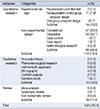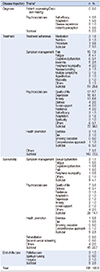Abstract
Purpose
The purpose of this study was to analyze and identify recent trends of published research in Asian Oncology Nursing (AON).
Methods
A total of 140 studies were analyzed using a tool developed by the researchers, focusing on research design, research subject, research themes, and type of interventions and outcome variables of experimental studies.
Results
AON lacked studies which were supported by research funds (27.9%), or used an experimental study design (10.0%). In particular, there were only 2 studies (1.4%) conducted with randomized controlled trials (RCT). Research subjects were various, including patients with cancer, family care givers, healthy population, and oncology nurses. Based on a framework of cancer control continuum, most studies addressed issues of the treatment phase, whereas few studies addressed issues of diagnosis, survivorship, or the end-of-life (EOL) phase. Regarding research themes, psychosocial nursing including quality of life, anxiety, and depression was most frequently reported. In the experimental studies, an education program was most frequently applied and psycho-social-spiritual variables and symptoms were most frequently used to evaluate the effects of the intervention.
Figures and Tables
Table 1
Research Design (N=140)

Table 2
Research Subjects (N=140)

Table 3
Research Theme of Studies Performed in Cancer Patients (N=85)

Table 4
Research Theme in Studies Performed in Non-cancer Patients (N=27)

Table 5
Characteristics of the Experimental Researches (N=14)

References
1. Korea Central Cancer Registry. Cancer facts and figures 2012. Accessed Feb 23, 2015. http://www.cancer.go.kr.
2. Jun M, So HS, Choi KS, Chung BY, Ryu E, Lee DS, et al. Analysis of research papers published by three nursing journals to suggest the direction of Journal of Korean Oncology Nursing. J Korean Oncol Nurs. 2011; 11(2):163–170.

3. Molassiotis A, Gibson F, Kelly D, Richardson A, Dabbour R, Ahmad AM, et al. A systematic review of worldwide cancer nursing research: 1994 to 2003. Cancer Nurs. 2006; 29:431–440.
4. Oncology Nursing Society. Oncology Nursing Forum. Accessed Feb 21, 2015. https://www.ons.org/practice-resources/periodicals.
5. Chung BY, Yi MS, Choi EH. Trends of Nursing Research in the Journal of Oncology Nursing. J Korean Oncol Nurs. 2008; 8:61–66.
6. Oh PJ. An integrative review of oncology nursing research in Korea: 2003-2008. J Korean Oncol Nurs. 2010; 10:80–87.
7. National Cancer Institute. Cancer Control Continuum. Accessed Mar 20, 2015. http://cancercontrol.cancer.gov/od/continuum.html.
8. Doorenbos AZ, Berger AM, Brohard-Holbert C, Eaton L, Kozachik S, LoBiondo-Wood G, et al. 2008 ONS research priorities survey. Oncol Nurs Forum. 2008; 35(6):E100–E107. https://onf.ons.org/onf/35/6/2008-ons-research-priorities-survey/html/full Accessed Mar 24, 2015.

9. Shin HS, Hyun MS, Ku MO, Cho MO, Kim SY, Jeong JS, et al. Analysis of research paper in the Journal of Korean Academy of nursing-focused on research trends, intervention studies, and level of evidence in the research. J Korean Acad Nurs. 2010; 40(1):139–149.

10. Choe MA, Kim NC, Kim KM, Kim SJ, Park KS, Byeon YS, et al. Trends in nursing research in Korea: research trends for studies published from the inaugural issue to 2010 in the Journal of Korean Academy of Nursing and the Journals published by member societies under korean academy of nursing science. J Korean Acad Nurs. 2014; 44(5):484–494.

12. Wallin L. Knowledge translation and implementation research in nursing. Int J Nurs Stud. 2009; 46:576–587.

13. Lee EH, Chung BY, Chun N, Oh PJ, Cho SY. Prioritization of research topics of korean oncology nurses. Asian Oncol Nurs. 2013; 13(4):259–303.

14. LoBiondo-Wood G, Knobf MT, Mallory G, Von Ah D. Priorities for oncology nursing research: The 2013 national survey. Oncol Nurs Forum. 2014; 41(1):67–76.

15. Oncology Nursing Society. The 2009-2013 Research Agenda for Oncology Nursing. Oncol Nurs Forum. 2009; 36(5):E274–E282. https://onf.ons.org/onf/36/5/2009-2013-research-agenda-oncology-nursing/html/full Accessed Mar 24, 2015.




 PDF
PDF ePub
ePub Citation
Citation Print
Print


 XML Download
XML Download